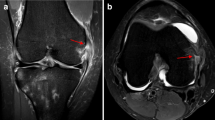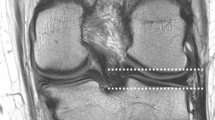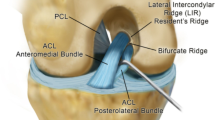Abstract
Purpose
This study aimed to investigate the morphological patterns of remnant anterior cruciate ligament bundles after injury (ACL remnant) on three-dimensional computed tomography (3DCT) and compare them with those on arthroscopy.
Methods
Sixty-three patients (33 males and 30 females; mean age 25.2 ± 10.1 years) who had undergone primary ACL reconstruction between March 2011 and December 2012 were included in this study. The average durations between traumas and 3DCT and between 3DCT and surgery were 101.7 ± 87.2 and 38.2 ± 38.7 days, respectively. ACL remnants were classified into four morphological patterns on 3DCT. 3DCT findings were compared with arthroscopic findings with and without probing.
Results
The morphological patterns of the ACL remnants on 3DCT were well matched with those on arthroscopy without probing (the concordance rate was 77.8 %). However, the concordance rate was reduced to 49.2 % when arthroscopic probing was used to confirm the femoral attachment of ACL remnants (p ≤ 0.05).
Conclusions
This study demonstrates that the morphological patterns of ACL remnants on 3DCT were well matched with those on arthroscopy without probing. Therefore, the technique can be useful for preoperative planning of the ACL reconstruction or informed consent to the patients. However, for definitive diagnosis, arthroscopic probing is required.
Level of evidence
IV.


Similar content being viewed by others
References
Adachi N, Ochi M, Uchio Y, Sumen Y (2000) Anterior cruciate ligament augmentation under arthroscopy: a minimum 2-year follow-up in 40 patients. Arch Orthop Trauma Surg 120:128–133
Adachi N, Ochi M, Uchio Y, Iwasa J, Ryoke K, Kuriwaka M (2002) Mechanoreceptors in the anterior cruciate ligament contribute to the joint position sense. Acta Orthop Scan 73:330–334
Adachi N, Ochi M, Uchio Y, Iwasa J, Kuriwaka M, Ito Y (2004) Reconstruction of the anterior cruciate ligament: single- versus double-bundle multistranded hamstring tendons. J Bone Joint Surg Br 86:515–552
Ahn JH, Lee YS, Ha HC (2009) Anterior cruciate ligament reconstruction with preservation of remnant bundle using hamstring autograft: technical note. Arch Orthop Trauma Surg 129:1011–1015
Ahn JH, Lee SH, Choi SH, Lim TK (2010) Magnetic resonance imaging evaluation of anterior cruciate ligament reconstruction using quadrupled hamstring tendon autografts: comparison of remnant bundle preservation and standard technique. Am J Sports Med 38:1768–1777
Araki D, Kuroda R, Matsushita T, Matsumoto T, Kubo S, Nagamune K, Kurosaka M (2013) Biomechanical analysis of the knee with partial anterior cruciate ligament disruption: quantitative evaluation using an electromagnetic measurement system. Arthroscopy 29:1053–1062
Bali K, Dhillon MS, Vasistha RK, Kakkar N, Chana R, Prabhakar S (2012) Efficacy of immunohistological methods in detecting functionally viable mechanoreceptors in the remnant stumps of injured anterior cruciate ligaments and its clinical importance. Knee Surg Sports Traumatol Arthrosc 20:75–80
Christel PS, Akgun U, Yasar T, Karahan M, Demirel B (2012) The contribution of each anterior cruciate ligament bundle to the Lachman test: a cadaver investigation. J Bone Joint Surg Br 94:68–74
Colombet P, Dejour D, Panisset JC, Siebold R (2010) The French Arthroscopy Society (2010) current concept of partial anterior cruciate ligament ruptures. Orthop Traumatol Surg Res 965:S109–S118
Crain EH, Fithian DC, Paxton EW, Luetzow WF (2005) Variation in anterior cruciate ligament scar pattern: does the scar pattern affect anterior laxity in anterior cruciate ligament-deficient knees? Arthroscopy 21:19–24
Delin C, Silvera S, Coste J, Thelen P, Lefevre N, Ehkirch FP, Le Couls V, Oudjit A, Radier C, Legmann P (2013) Reliability and diagnostic accuracy of qualitative evaluation of diffusion-weighted MRI combined with conventional MRI in differentiating between complete and partial anterior cruciate ligament tears. Eur Radiol 23:845–854
Gohil S, Annear PO, Breidahl W (2007) Anterior cruciate ligament reconstruction using autologous double hamstrings: a comparison of standard versus minimal debridement techniques using MRI to assess revascularisation. A randomised prospective study with a one-year follow-up. J Bone Joint Surg Br 89:1165–1171
Lefevre N, Naouri JF, Bohu Y, Klouche S, Herman S (2014) Partial tears of the anterior cruciate ligament: diagnostic performance of isotropic three-dimensional fast spin echo (3D-FSE-Cube) MRI. Eur J Orthop Surg Traumatol 24:85–91
Lintner DM, Kamaric E, Moseley JB, Noble PC (1995) Partial tears of the anterior cruciate ligament: are they clinically detectable? Am J Sports Med 23:111–118
Muneta T, Koga H, Ju YJ, Horie M, Nakamura T, Sekiya I (2013) Remnant volume of anterior cruciate ligament correlates preoperative patients’ status and postoperative outcome. Knee Surg Sports Traumatol Arthrosc 21:906–913
Nakamae A, Ochi M, Deie M, Adachi N, Kanaya A, Nishimori M, Nakasa T (2010) Biomechanical function of anterior cruciate ligament remnants: how long do they contribute to knee stability after injury in patients with complete tears? Arthroscopy 26:1577–1585
Nakamura E, Mizuta H, Kadota M, Katahira K, Kudo S, Takagi K (2004) Three-dimensional computed tomography evaluation of semitendinosus harvest after anterior cruciate ligament reconstruction. Arthroscopy 20:360–365
Nakasa T, Fukuhara K, Adachi N, Ochi M (2006) Evaluation of anterior talofibular ligament lesion using 3-dimensional computed tomography. J Comput Assist Tomogr 30:543–547
Ng AW, Griffith JF, Hung EH, Law KY, Yung PS (2013) MRI diagnosis of ACL bundle tears: value of oblique axial imaging. Skeletal Radiol 42:209–217
Ochi M, Adachi N, Deie M, Kanaya A (2006) Anterior cruciate ligament augmentation procedure with a 1-incision technique: anteromedial bundle or posterolateral bundle reconstruction. Arthroscopy 22(463):e1–e5
Ochi M, Adachi N, Uchio Y, Deie M, Kumahashi N, Ishikawa M, Sera S (2009) A minimum 2-year follow-up after selective anteromedial or posterolateral bundle anterior cruciate ligament reconstruction. Arthroscopy 25:117–122
Panisset JC, Ntagiopoulos PG, Saggin PR, Dejour D (2012) A comparison of Telos™ stress radiography versus Rolimeter™ in the diagnosis of different patterns of anterior cruciate ligament tears. Orthop Traumatol Surg Res 98:751–758
Pelc JS, Beaulieu CF (2001) Volume rendering of tendon-bone relationships using unenhanced CT. AJR Am J Roentgenol 176:973–977
Samuelsson K, Desai N, McNair E, van Eck CF, Petzold M, Fu FH, Bhandari M, Karlsson J (2013) Level of evidence in anterior cruciate ligament reconstruction research: a systematic review. Am J Sports Med 41:924–934
Siebold R, Fu FH (2008) Assessment and augmentation of symptomatic anteromedial or posterolateral bundle tears of the anterior cruciate ligament. Arthroscopy 24:1289–1298
Sunagawa T, Ochi M, Ishida O, Ishiburo M, Suzuki O, Yasunaga Y, Ochi M (2003) Three-dimensional CT imaging of flexor tendon ruptures in the hand and wrist. J Comput Assist Tomogr 27:169–174
Uozumi H, Aizawa T, Sugita T, Kunii T, Abe S, Itoi E (2013) Visualization of torn anterior cruciate ligament using 3-dimensional computed tomography. Orthop Rev (Pavia) PMID: 24191182
Van Dyck P, Vanhoenacker FM, Gielen JL, Dossche L, Van Gestel J, Wouters K, Parizel PM (2011) Three tesla magnetic resonance imaging of the anterior cruciate ligament of the knee: can we differentiate complete from partial tears? Skeletal Radiol 40:701–707
Van Eck CF, Schreiber VM, Mejia HA, Samuelsson K, van Dijk CN, Karlsson J, Fu FH (2010) “Anatomic” anterior cruciate ligament reconstruction: a systematic review of surgical techniques and reporting of surgical data. Arthroscopy 26:S2–S12
Yamamoto T, Kurosaka M, Soejima T, Fujii M (2001) Contrast-enhanced three-dimensional helical CT for soft tissue tumors in the extremities. Skeletal Radiol 30:384–387
Conflict of interest
The authors report that they have no conflict of interest in the authorship and publication of this article.
Author information
Authors and Affiliations
Corresponding author
Rights and permissions
About this article
Cite this article
Adachi, N., Ochi, M., Takazawa, K. et al. Morphologic evaluation of remnant anterior cruciate ligament bundles after injury with three-dimensional computed tomography. Knee Surg Sports Traumatol Arthrosc 24, 148–153 (2016). https://doi.org/10.1007/s00167-014-3354-1
Received:
Accepted:
Published:
Issue Date:
DOI: https://doi.org/10.1007/s00167-014-3354-1




